Flow
by SealWyf, HSM editor
The Palace of the Seven Winds has revolutionized Home. This is not too strong a word. All future private spaces, and some public ones as well, will use this space as a milestone and a yardstick. It was here that it all came together. The Palace of the Seven Winds taught us how to fly.
You understand that I don’t just mean getting off the ground. We did that in Novus Prime, with the zero gravity game. And again in Avalon Keep, where we could embody our consciousness in a mechanical dragonfly to tour our apartment. And to some extent we saw flying, in the form of swimming, in Dream Island and the Glittering Sands beaches, where simply entering the water changed how you moved. And now, of course, we have purchased locomotions that let you fly (or something close to it) in any public space. These were all worthy advances. Each one changed the way we interacted with Home, and even how we felt about it.
But these were all precursors and also-rans to the real thing. This is not to diminish their achievement. Someone has to be the pioneer. But Seven Winds is different. It has passed an unsuspected threshold between quantitative change to qualitative transformation. It has reached critical mass. With this space, Home itself has evolved.
Let me explain: when you fly in Seven Winds, you are no longer a person holding a controller. You are there.
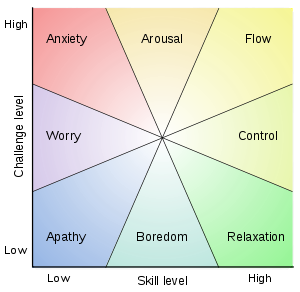 Psychologists call it flow — the blissful state when the interface and tools of craft melt away, and we become one with the thing we are doing. It’s a state well known to video gamers, and we treasure the games that let us experience it. The creations of thatgamecompany show it best — the appropriately-named flOw, Flower, and most recently, Journey. They are Zen games. You do not play them so much as become one with the experience.
Psychologists call it flow — the blissful state when the interface and tools of craft melt away, and we become one with the thing we are doing. It’s a state well known to video gamers, and we treasure the games that let us experience it. The creations of thatgamecompany show it best — the appropriately-named flOw, Flower, and most recently, Journey. They are Zen games. You do not play them so much as become one with the experience.
To be honest, the technical definition of “flow” refers to what happens in the mind of someone who masters a difficult craft. One example is the unity of the musician with his instrument. A skilled musician no longer thinks about the mechanics of playing — he becomes the music.
But this is one of the joys and gifts of gaming. A well-made video game can give us the same ecstatic absorption, the same merging of mind with action. The same feeling of effortless mastery, without the years of diligent practice required in the real word. In gaming, we can play at mastery, in the same way we play at saving the world. If this is a cheat, the human mind is complicit in it.
Flow depends on a simple, intuitive, instantaneous linking of control and action, so the mind absorbs the controller and lets it vanish. When you are in flow, you no longer think, “I will push forward on the left stick.” You simply think “I’m going over there.” And you do.
Once the conditions are present, achieving flow is surprisingly easy. Our brains are pre-adapted to absorbing the interface and making it part of our intention. It’s what we do when we move our bodies. You don’t think about your arms and legs, unless something brings them to your attention. Most of the time, your body is invisible. It is simply part of “you”. In gaming, the mind makes the controller an extension of the body — another part of “you”.
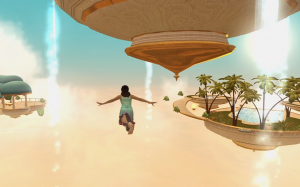 I have no doubt that in the future, when we can transfer our minds into other mechanical or biological bodies, the hard part will be designing them. Using them, mentally moving into them, will be simple. The merge will be intuitive and seamless. We are already built to make it happen.
I have no doubt that in the future, when we can transfer our minds into other mechanical or biological bodies, the hard part will be designing them. Using them, mentally moving into them, will be simple. The merge will be intuitive and seamless. We are already built to make it happen.
The experience of flow is rare in Home, due to the constraints of client-server connections. It is hard to achieve the instantaneous action-and-reaction that lets the interface vanish. To date, the only real examples have been the major Sodium games, Salt Shooter and Sodium 2. Of all the games in Home, only these had the immersive immediacy of a disc-based title. Other Home games may have been entertaining, but there was always a sense of disconnect, a consciousness of being a player holding a controller. A perception, however slight, of lag. Lag is the enemy of flow.
It is impossible to avoid comparing Palace of the Seven Winds with Avalon Keep. Both are collections of sky islands in a fantasy universe, rendered in a style that leans toward the non-realist. Both use animated non-player characters as controls. Both let the owner change the time of day and the appearance of major decorations. Both make heavy use of mood music. And both include flight.
Flight in Avalon uses the metaphor of a mechanical dragonfly — a tool, rather than your own avatar. The controls are clunky compared to the fluid, intuitive flight of Seven Winds. You never forget that you are steering a vehicle.
The dragonfly was impressive when we first saw it. And it’s lucky we saw it first, because it set the stage for the vastly superior flight experience of Seven Winds. In Avalon, flying is an optional activity. You can enjoy the space without ever taking to the air. However, you cannot be in Seven Winds for any length of time without flying. It’s the only way to get from one island to another. Even within the central palace, there are areas you cannot reach on foot.
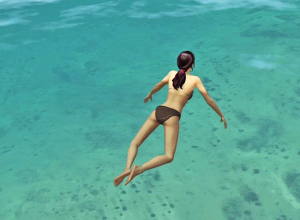 The way you start to fly is also revolutionary. The only place we have seen something similar is in the Dream Island and Glittering Sands beaches, where you automatically start swimming when you enter the water, and return to normal locomotion when you reach the shallows. The fact that these new intuitive transitions came out all at once hint at deep changes in Home’s core client over the past several months, and new tools available to developers.
The way you start to fly is also revolutionary. The only place we have seen something similar is in the Dream Island and Glittering Sands beaches, where you automatically start swimming when you enter the water, and return to normal locomotion when you reach the shallows. The fact that these new intuitive transitions came out all at once hint at deep changes in Home’s core client over the past several months, and new tools available to developers.
In Seven Winds, flying does not require any special action on your part. Yes, there is a launch platform on each island, where you can stand to enter flight. But the more intuitive, the more deeply satisfying way to fly is simply to step off the edge into empty air. For a moment you fall. Then the program catches you and launches you into flight. It is exactly the sensation of diving into a swimming pool and being buoyed up by the water. There is a moment of doubt, the emotional clench of apparent danger, followed by the exhilaration of control.
A similar intuitive transition is used in the large swimming pool on the lower island. You dive from a higher platform, and suddenly you are swimming. When you reach the steps out of the pool, you return to normal locomotion. It is very nearly seamless.
The only violation of seamless transition comes when you exit flight. To return to normal locomotion, you must hit the start button and select Exit Flight. The use of the dialog breaks the dreamlike state. It would have been better to assign a normal controller button or button combination to the exit function.
Flight in Seven Winds becomes even more dreamlike, more joyfully intuitive, with music. The genie Faruk, who serves as your general factotum, is also your music player. There are several choices on his playlist, all Middle Eastern in style, and all glorious for flying.
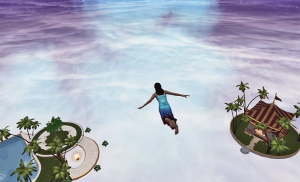 So now, turn on the music, and step off the edge. You fall, but the wind catches you, as you knew it would. You swoop among the islands in half-conscious choreography, circling the golden domes, gliding into the palace to hover under the patterned gold of the ceiling, then swooping back down and out, across space to the island of the pool, where you pass among the palm trees and attempt to fly behind the waterfalls. (Alas, that is not permitted.)
So now, turn on the music, and step off the edge. You fall, but the wind catches you, as you knew it would. You swoop among the islands in half-conscious choreography, circling the golden domes, gliding into the palace to hover under the patterned gold of the ceiling, then swooping back down and out, across space to the island of the pool, where you pass among the palm trees and attempt to fly behind the waterfalls. (Alas, that is not permitted.)
You drop from flight into the water and swim, then climb back out and once more step off the edge, falling and spinning upwards, then soaring until you feel the impediment of invisible walls. You hang in air, contemplating your island kingdom while the sky slides from day into sunset, from starry night into radiant morning. And the music fills the space, sourceless and directionless, transforming this mere virtual apartment into a waking dream.
Coming back to earth, you wonder how could this be improved. It feels almost ungrateful to bring up the question, like complaining that your shiny new Christmas bicycle should have been a pony. But development in Home is an iterative process. Experiences are designed, consumed and analyzed. And from the feedback, new experiences are created. And this glorious addition to the Home vocabulary, this paradise of intuitive flight could be the seed for something even more amazing.
For now, I’ll make three points. The first I have already mentioned: while entering flight is seamless, leaving it is less so. Hitting the Start button to bring up a dialog, and then hitting X for Exit Flight breaks the dream. The Circle button is traditionally assigned to the “Cancel” function, and perhaps it could be used here. In Seven Winds flight, it simply toggles the onscreen instructions, a courtesy for videographers, or indeed anyone who values an uncluttered interface. But the Square button is currently unassigned. Perhaps the control toggle could be moved there, and Circle could become another Exit Flight.
Another non-intuitive control choice is the use of R2 and L2 for vertical motion. In the games flOw and Flower, tipping the controller steers the character. Could controller angle be used in a Home game? If so, it should be added to the flight control set.
The second improvement I would urge is an in-flight camera, if memory constraints can possibly allow it. At the moment, the only way to document your flight is through video capture. This is an obvious area for an upgrade, and I wonder if the Square button is being reserved for this function. Square has been the shutter button for other in-Home cameras.
The third improvement is something I suspect is already in the works. And it is simply this: as glorious as flying is, it lacks a point. And an interface this fine demands to be turned into a game.
I can see this new flight engine as the heart of a multiplayer platformer, with avatars swooping through strings of levitating power-coins, battling aerial monsters, diving through hoops in a grand race, or simply playing tag. Can we hope for something resembling the Blitzball game in Final Fantasy X, or even a Home version of Quidditch? I doubt that the Juggernaut programmers would have put in the amount of work the flight engine implies, if they did not have larger plans for it.
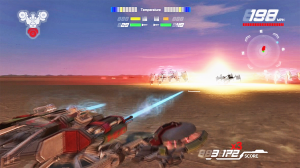 We now know that flow in Home is possible. Salt Shooter and Sodium 2 introduced it, in the context of vehicle-based games. The Palace of the Seven Winds has carried it to new heights, using our own avatars as the vehicles. The limit now is, literally, the sky.
We now know that flow in Home is possible. Salt Shooter and Sodium 2 introduced it, in the context of vehicle-based games. The Palace of the Seven Winds has carried it to new heights, using our own avatars as the vehicles. The limit now is, literally, the sky.
This is a transformative moment in Home, the first glimpse of a distant radiance. The vision is tinged with potential, and also with hope.
Would developers, in and out of Sony, have put this much work into a platform that was doomed to early retirement? These new capabilities imply that Home has a future, that it will continue to evolve. And that what is still to come will be glorious.


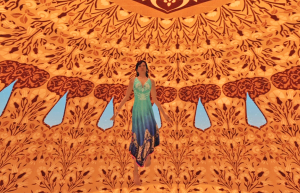
Excellent, Seal. Nice insights. I love the way your articles provide a wider context and philosophical underpinnings.
This article is awesome! I too, like to flow. Planetland begs for this feature as well.
Base jumping with wing suits. That would be a rush too!
Good read. One thing I will say though is about using the motion controls for flight -- no. Just, please no. As a gamer that regularly enters that timeless land of Zen, Ive always found motion controls to be counterproductive to the experience. Sitting still, in the dark, surround sound on, central to the screen and about 2 meters away is bang-on perfect for Zen. When you find that sweet spot everything vanishes. Ever stopped playing a game to suddenly realize the room is cold, it’s gone dark outside, you haven’t eaten for over 5 hours and your bladder is screaming at you? THAT’S Zen baby!
Anyways, I did enjoy this article with its musings of where Home might be headed in the future. I’m very glad for the locomotive improvements, but cant help think Home’s navigator system now bogs this idea down. It’d be great to see a vast plain or exploreable expanse between one space and the next. Call me boring but, I’d still like to see some serious roads connecting all spaces. Just to cruise them with friends in Home would be cool. Just think of all the bits of car fluff you could sell to us Sony!!!
Indeed. We could always use the Navigator to fast-path to places. But it would be great to have an alternative, “scenic route”.
Remember the “wood between the worlds” in “The Magician’s Nephew”? The long perspective hallway with randomly-connected doors in “Yellow Submarine”? Something like that, perhaps. Or even that endless highway in “Final Fantasy X”, where you might meet other travelers and have random monster encounters while traveling to the next city.
Perhaps the connectivity of the scenic route could change from time to time, so you need to do a bit of exploring. Exploring could be rewarded. Get people out there looking at things and talking to others, trading tips, like the helpful strangers in “Journey”. And perhaps the scenic route could connect to all those old spaces currently off the grid, the ones you need to have bookmarked to reach. It would be another motive for exploration. What’s out there that most people don’t know about? Let me show you…
If you want to turn Home into a game, this is one obvious way to do it.
Yeah, if they couldnt make it big enough to drive around, you could have it like a city outside Adventure District, a jungle around Adventure etc. Not sure how they’d all blend but I wouldn’t mind a few loading screens if it ment you could truly explore. Saying that (and I’m no expert here) I think this is probably far out of reach of the current Home engine to be possible. But it’s good to dream eh…